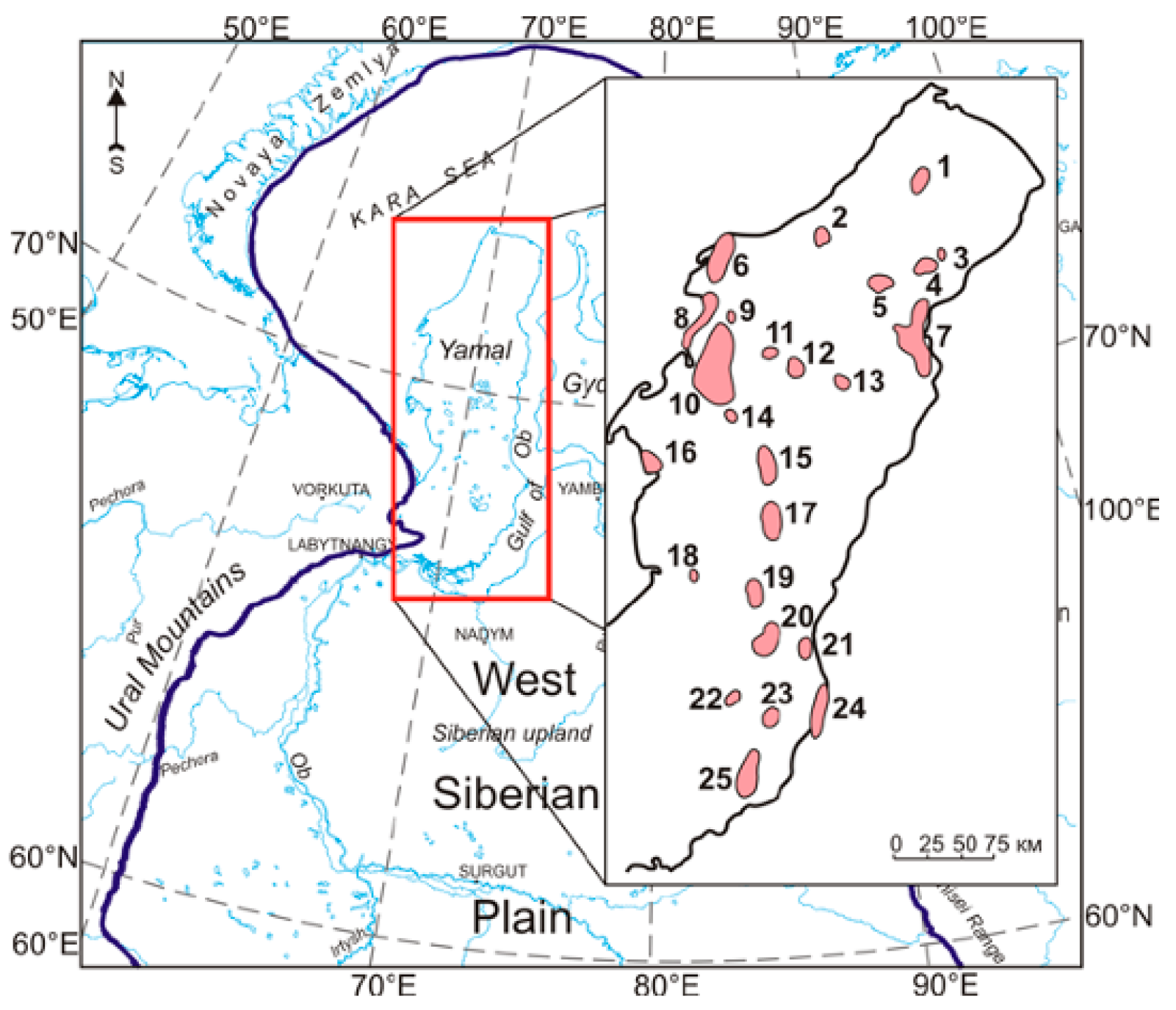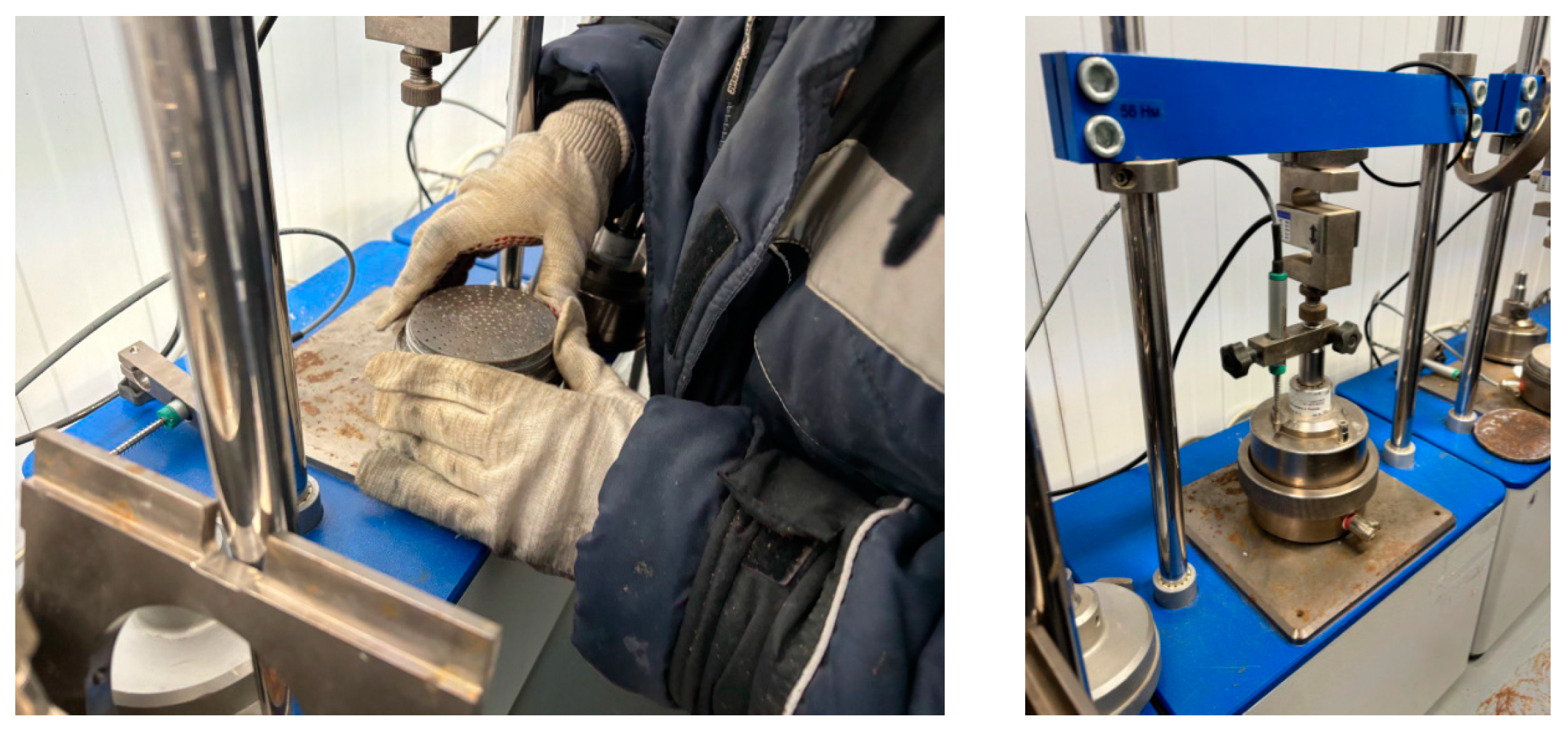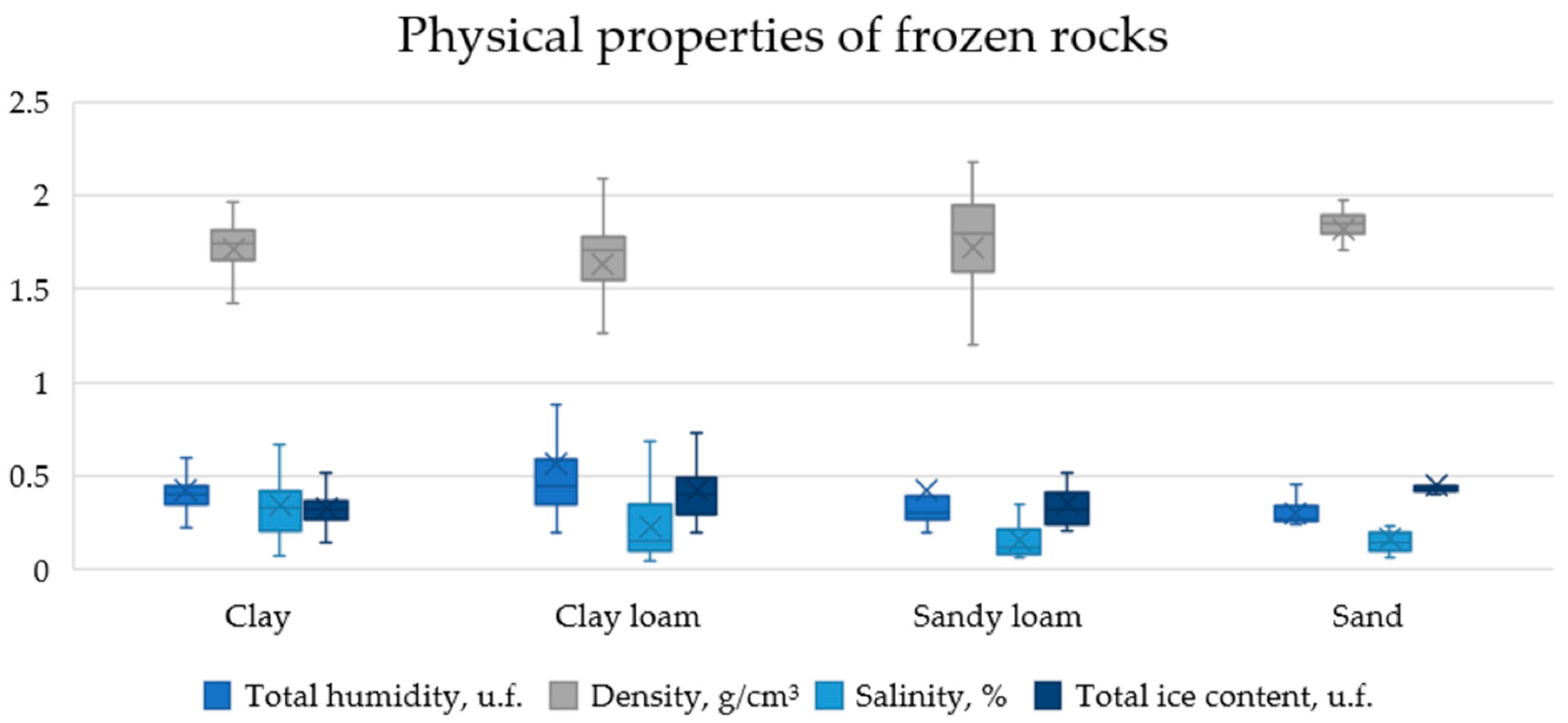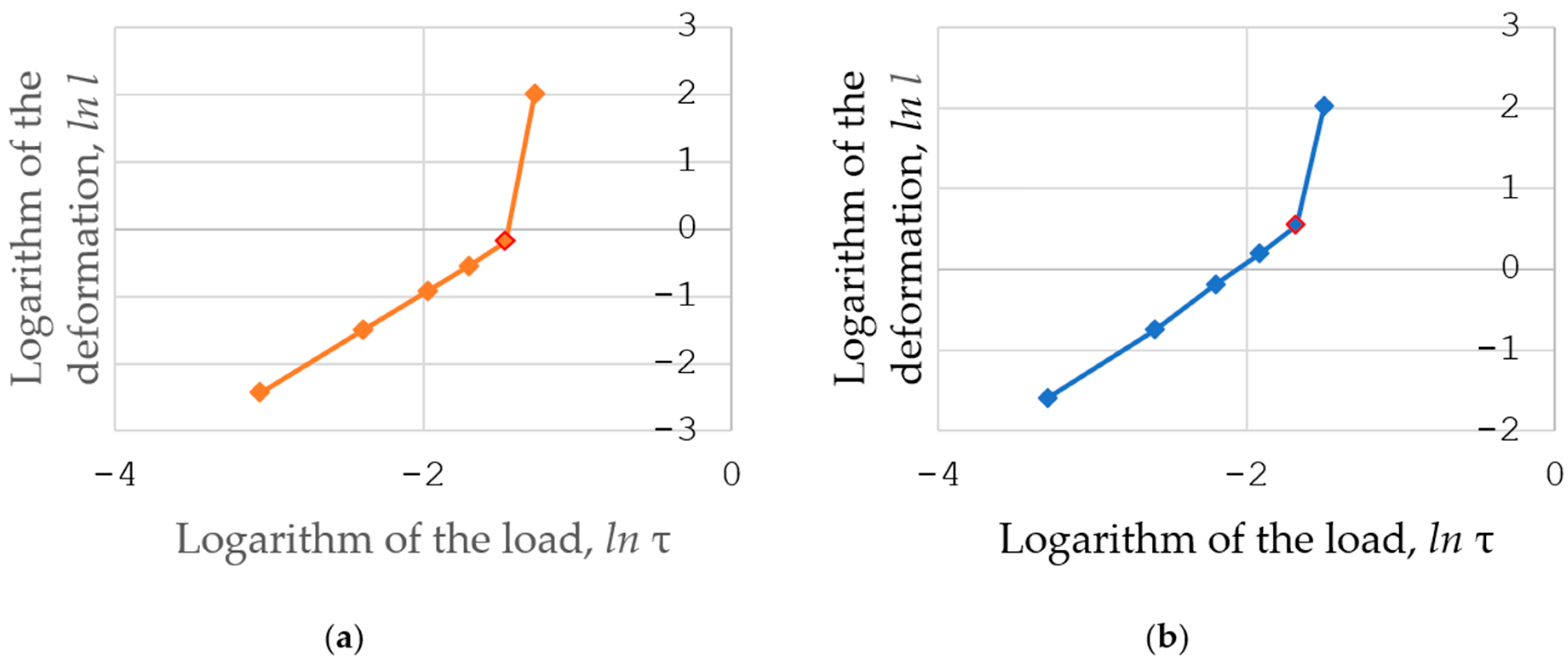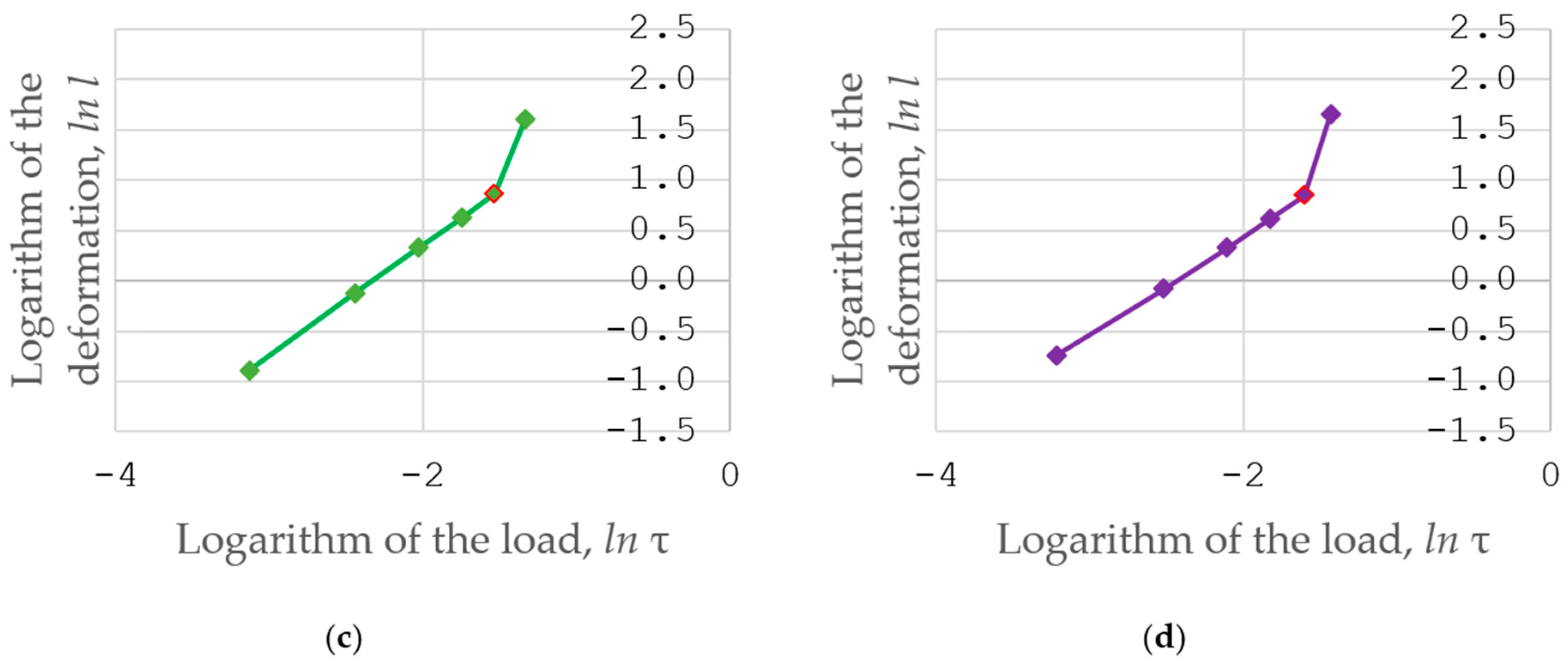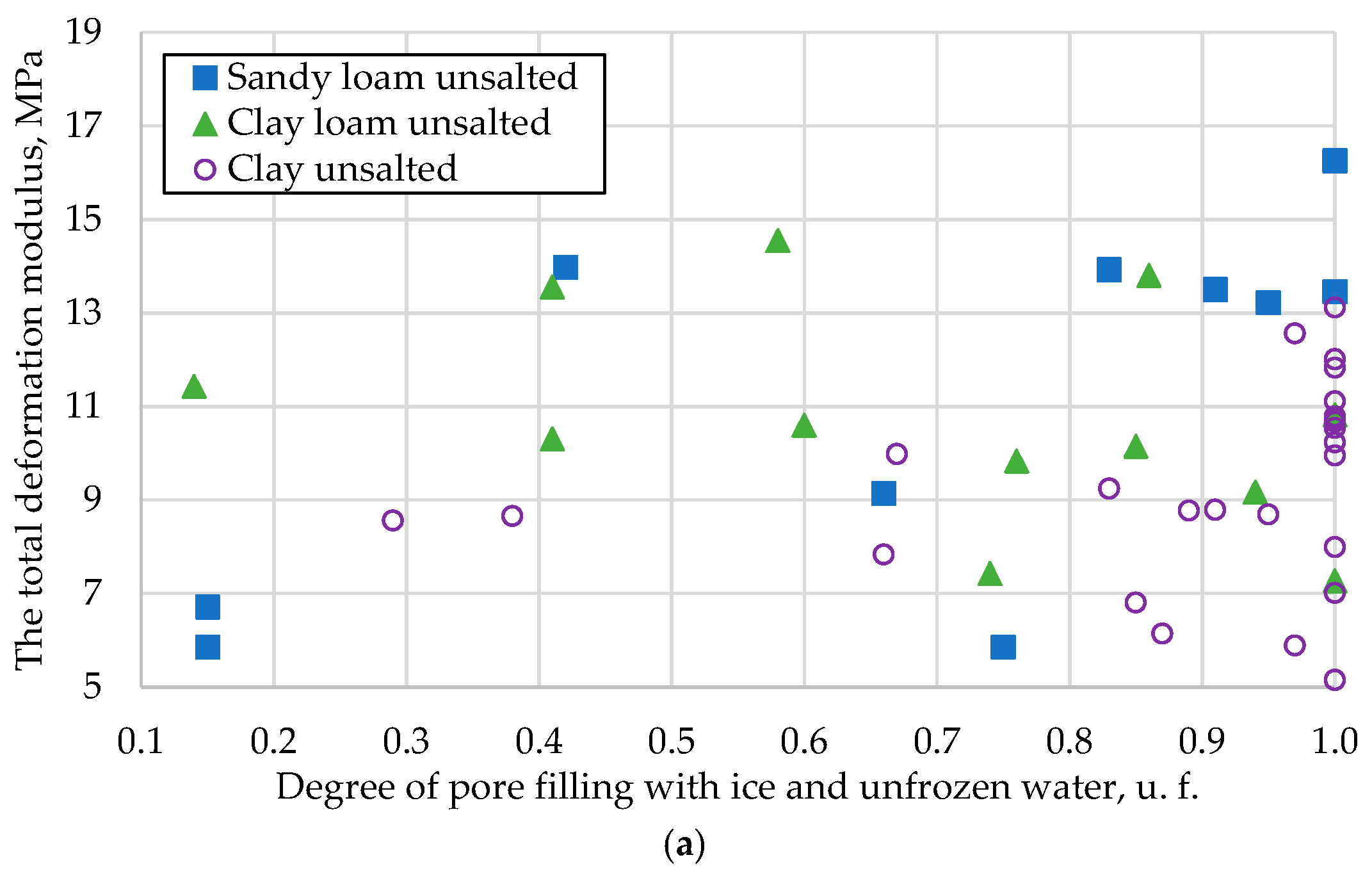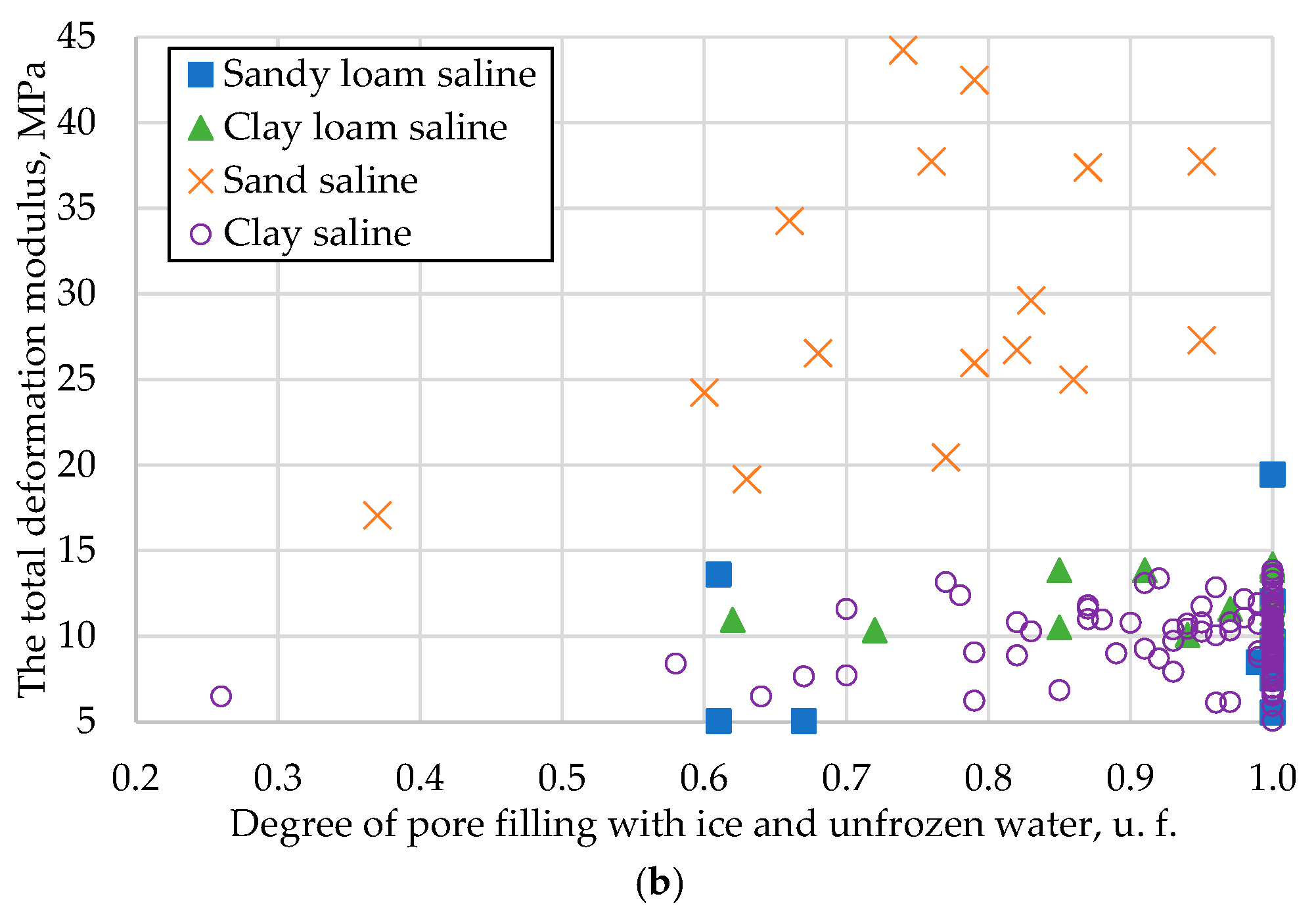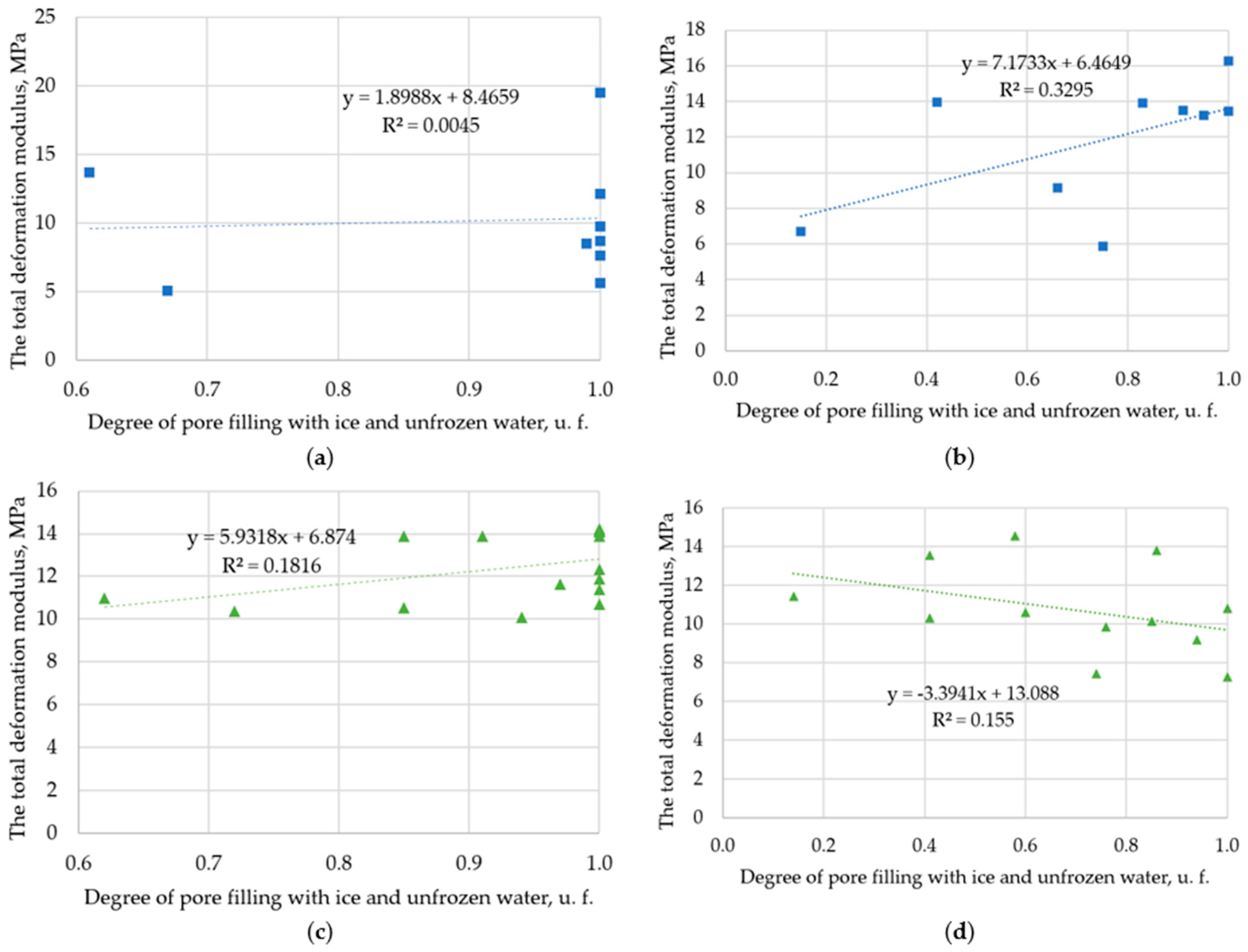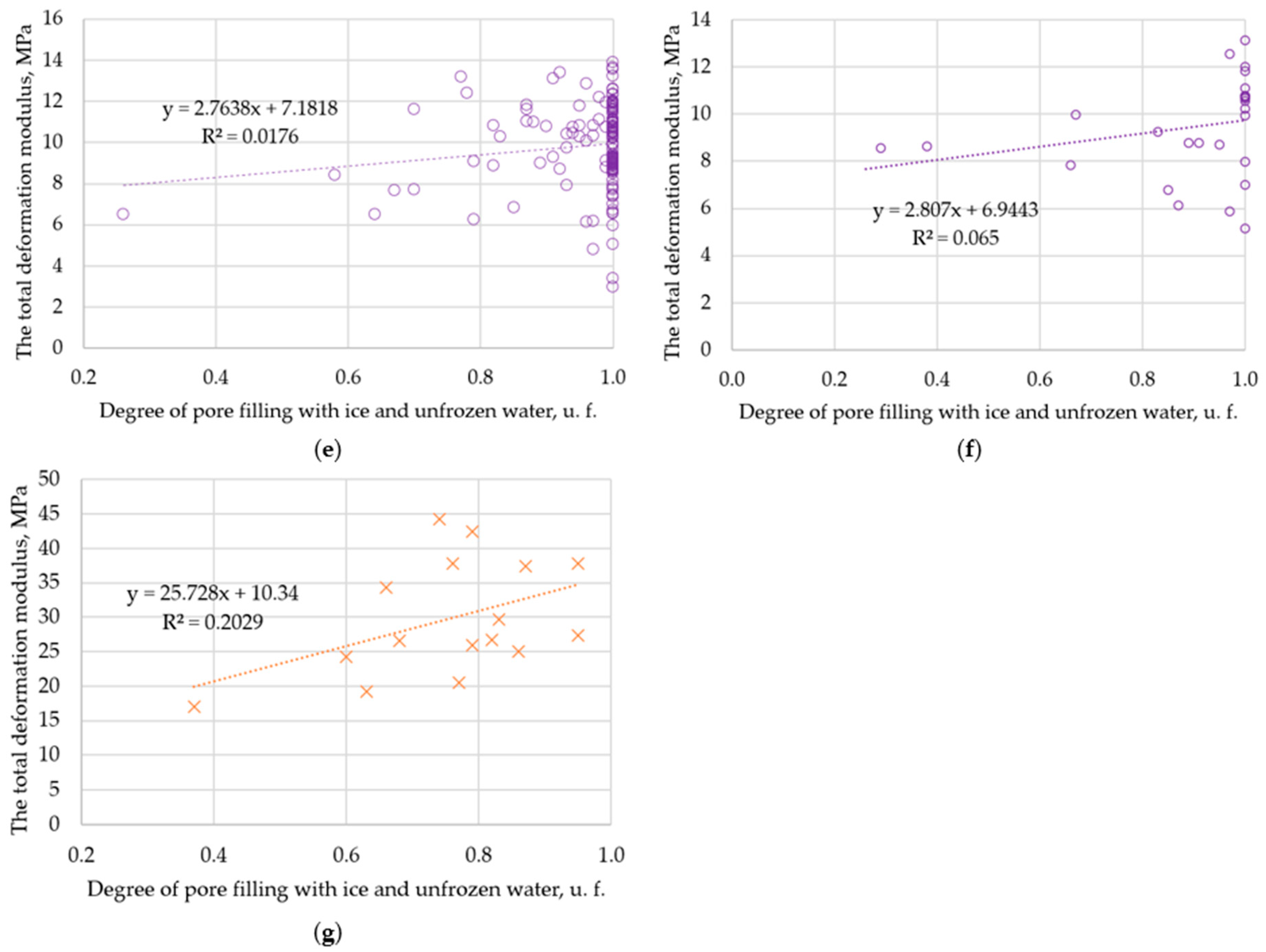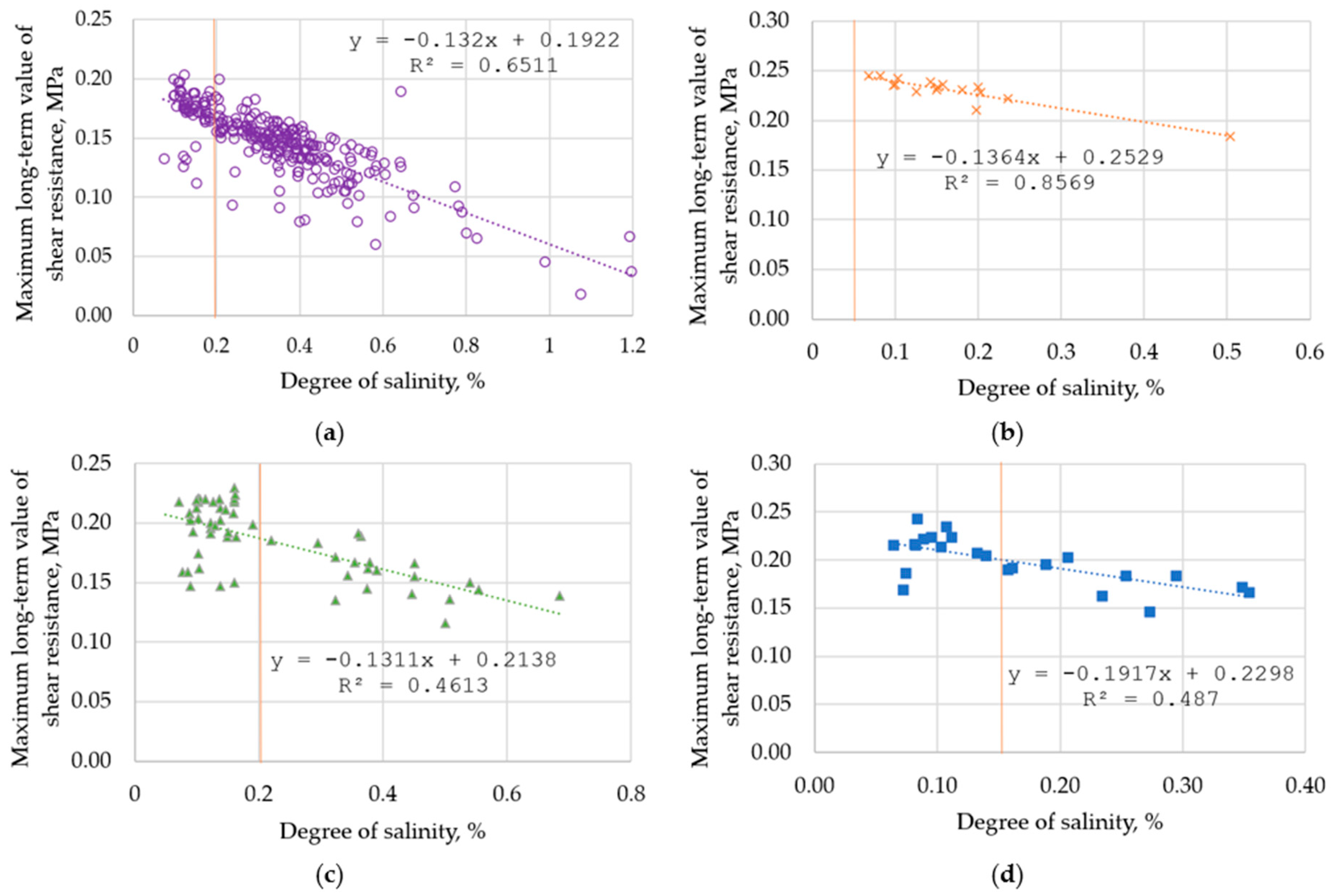1. Introduction
The active development of Arctic regions, particularly the Yamal Peninsula—characterized by widespread permafrost and large-scale oil and gas infrastructure projects—necessitates a deeper understanding of cryogenic processes and phenomena within frozen geological materials [
1,
2]. Resource extraction in permafrost zones presents unique challenges related to the specific behavior of these materials [
3]. Key features distinguishing the mechanical properties of frozen rocks include the dynamic equilibrium between unfrozen water and ice, pronounced rheological behavior, and inherent instability of mechanical properties [
4,
5,
6]. It is well-established [
7,
8,
9] that the strength of frozen materials is significantly influenced by factors such as porosity, density, unfrozen water content, temperature, mineral structure characteristics, and loading rate. Insufficient consideration of these factors can lead to a complete loss of foundation bearing capacity [
10] and serious environmental problems [
11]. Common hazards resulting from anthropogenic activities include reduced rock bearing capacity, frost heave and settlement affecting surface and buried structures, gravitational mass movements, and others [
12]. Ensuring the stability of foundations on frozen ground requires precise determination of their physical and mechanical properties, alongside the development of reliable methods for predicting property changes [
13] and effective stabilization solutions [
14,
15,
16].
Modern development of Arctic territories, marked by complex geocryological conditions, demands an integrated approach [
17] that incorporates both findings from frozen rock research and advancements in related fields. Achieving reliable forecasts necessitates the use of contemporary methods for characterizing rock properties, including techniques adapted from the mining industry [
18,
19,
20]. Numerical modeling has become an essential tool [
21,
22], enabling the prediction of the behavior of complex geomechanical systems [
23,
24,
25], with the finite element method proving particularly useful for assessing the influence of various factors [
26,
27,
28]. Furthermore, successful Arctic development is contingent upon optimizing technological processes and effective resource management [
29,
30].
Given the challenging operating environment for structures in the Arctic, the use of advanced materials and technologies is crucial to ensure structural reliability and durability [
31,
32,
33]. It is vital to study the factors affecting structural stability [
34], especially under the conditions of long-term operations [
35,
36]. Concurrently, understanding the specifics of each deposit and related geological features [
37,
38,
39], as well as the influence of external factors, including dynamic loads [
40,
41,
42], is important.
The inherent variability of frozen rock behavior in time and space [
43,
44] underscores the need for a thorough investigation of its physical and mechanical properties. Unlike thawed materials, frozen rocks exhibit strength and deformation characteristics that vary widely depending on temperature, moisture content, mineral composition, ice content, structure type, and load application rate [
45,
46]. These properties are also highly susceptible to changes upon thawing, resulting in strength loss, increased compressibility, and settlement or deformation that can significantly exceed allowable limits for foundations and structures [
47,
48].
The study area is located on the Yamal Peninsula in the Arctic region of Russia (
Figure 1). Samples were collected from the Kharasaveyskoye gas condensate field (coordinates: 71°11′05″ N, 66°53′50″ E). On the Yamal Peninsula, where weak, dispersed frozen rocks with varying degrees of salinity are common, and whose bearing capacity decreases significantly with the increasing temperature [
49], determining the mechanical properties and behavior under diverse load and temperature conditions is particularly critical [
50,
51]. The salinity of frozen rocks can also significantly alter their physical and mechanical properties by lowering the freezing point, potentially reducing strength, and increasing deformability [
52,
53]. Therefore, predicting foundation deformations and stability, determining the adfreeze strength between frozen rock and foundation materials [
54,
55], and selecting optimal construction and foundation strengthening methods [
56] are primary tasks for the successful development of the region. Consequently, determining the changes in the physical and mechanical properties of frozen rocks in Arctic territories, along with improving existing methods for studying their mechanical behavior, are key factors for the successful and sustainable development of these regions [
57,
58].
2. Materials and Methods
The analysis of physical and mechanical properties was carried out for the rocks of the Kharasaveyskoye gas condensate field located on the western coast of the Yamal Peninsula, in the immediate vicinity of the Kara Sea. This area is characterized by a complex geological structure, including the presence of frozen rocks of various compositions and ice content, as well as saline rocks in the coastal zone [
43]. Upper Pleistocene-Holocene marine sediments are involved in the geological structure of the site. Permafrost rocks are mainly represented by clays and clay loams, less often sandy loams and sands.
Sampling was carried out to conduct a complex of laboratory tests, including the study of the physical and mechanical characteristics of frozen rocks. To preserve the structure of the samples, special methods and equipment were used during sampling, which minimized mechanical impact. The physical properties were determined in accordance with GOST 5180 [
60] and GOST 12536 [
61]. For each of the 380 samples, humidity, density, granulometric composition, organic matter content, degree of salinity, and ice content were determined in laboratory conditions.
The mechanical characteristics were determined in accordance with GOST 12248.8 [
62] and GOST 12248.10 [
63] and included the following:
Determination of the deformability characteristics of frozen soils by compressive stress;
Determination of the strength characteristics of frozen soils by the method of cutting along the freezing surface.
Both the compression and shear test along the freezing surface were conducted at a constant temperature of −3 °C.
For compression stress tests, 251 cylindrical samples with a diameter of 71.4 mm and a height of 35 mm were produced. A total of 362 samples shaped like cylinders with a diameter of 71.4 mm and a height of 35 mm were produced for testing by the method of cutting along the freezing surface. Immediately before the test, the samples were kept at a constant negative temperature for at least 24 h, set for testing, in order to equalize the temperature over the entire thickness of the sample.
To carry out compression tests, a device for testing frozen rocks using the compression stress method of NPP Geotek LCC, Penza, Russia was used, as shown in
Figure 2. The sample was loaded by applying a stepwise increasing vertical load. Each load stage was set in accordance with the GOST 12248.8 methodology. The load was applied at a preset speed and maintained at each stage until the deformations were stabilized, which was controlled by a displacement sensor and a deformation stabilization criterion. During the tests, the vertical load, vertical deformation and time were determined. As a result of the processing, the compression factor and the deformation modulus were determined. The results obtained were used to plot the dependence of relative deformation on the applied load for each type of rock and for further analysis.
To determine the shear resistance of frozen rocks, the method of single-plane cutting along the freezing surface with the foundation material was used. The device of a single-plane cut was used. The device of a single-plane cut for testing frozen rocks of NPP Geotek LCC is shown in
Figure 3. The purpose of the test was to determine the shear resistance of frozen sands and clay rocks on the surface of their freezing with pile material. For testing, samples of undisturbed structure and rings with foundation material (steel of strength class 345 grade 09G2S according to GOST 19281 [
64]) were used. The diameter of the material sample was equal to the diameter of the rock sample.
According to GOST 12248.8, the tests were carried out according to the “soil-foundation material” scheme. The preparation for the test was carried out as follows: using a press and a sharp knife, samples of undisturbed structure were cut out with a working ring in a room with a constant negative temperature. A ring identical in size to the sample of the foundation material was installed on the working ring. After preparation, the samples were kept at a test temperature of at least 24 h before being installed in the test device, and then installed in a cutting unit.
The tests were carried out by applying a normal load to the sample installed in the device and then applying a shear load in steps until the deformation was conditionally stabilized. During the tests, the shearing load, deformation, and time were determined. After the tests were completed, the data obtained were processed to determine the characteristics of the adhesion strength of frozen rocks to the foundation material.
3. Results
As a result of the study of the physical properties of 380 samples of frozen rocks from the Yamal Peninsula, the values of their humidity, density, degree of salinity and ice content were obtained. It is important to recognize that the observed relationships are influenced by the complex interplay of multiple factors, and the bivariate analyses presented here serve as a foundation for understanding these intricate dependencies.
It was found that the total humidity of rocks varies depending on the type of rocks. Clay rocks tend to have higher humidity than sandy and clay loamy rocks.
Table 1 shows the results of a humidity study of the various types of rocks.
The density of frozen rocks also depends on the type of the rock, humidity, and ice content. The obtained rock density values are shown in
Table 2.
The total ice content is an important characteristic of frozen rocks, which has a significant effect on their mechanical properties. The values of the ice content of the frozen rocks are shown in
Table 3.
A characteristic feature of the studied frozen rocks is the presence of saline samples, ranging from slight to strong salinity. The maximum salinity values were observed in clays. The presence of salts in the frozen rocks affects the temperature at which water begins to freeze, which can also affect their mechanical properties. The results of the study of salinity of the various types of rocks are presented in
Table 4.
The results of the study of the physical properties of frozen rocks are shown in
Figure 4.
Compression tests were performed for 251 samples with undisturbed structures (with natural humidity and ice content) in a frozen state. As a result of the tests, graphs of the dependence of deformation on the applied load were obtained, which were used to find the deformation modulus of frozen rocks. The results of compression tests for frozen rocks are shown in
Figure 5.
As a result of the tests performed by the single-plane cut method, the values of the maximum long-term shear resistance along the freezing surface of frozen rocks with foundation material for 362 samples were determined. The results of the frozen rock shear tests are shown in
Figure 6. The maximum long-term shear resistance value was defined as the highest shear stress, at which the deformation of the sample stabilized at a given normal stress.
4. Discussion
The analysis of the effect of the degree of pore filling with ice and unfrozen water on the deformation characteristics was carried out for frozen unsalted and saline rocks. The dependences of the deformation modulus obtained as a result of the compression tests on the degree of pore filling with ice and unfrozen water for rocks of various types and degrees of salinity are shown in
Figure 7 and
Figure 8. While this analysis focuses on the influence of pore filling with ice and unfrozen water and salinity, it is acknowledged that these factors interact significantly with temperature, confining pressure and rock structure, which were not explicitly varied or fully coupled in this specific analysis. A full understanding requires considering these coupled effects.
It is noted that saline rocks have more stable values of the deformation modulus. The deformation modulus of frozen saline rocks (especially clays and clay loams) is on average higher than that of unsalted rocks [
65]. This may be due to the influence of salts on increasing the tenacity of the frozen rock structure.
A general pattern of an increase in the deformation modulus with an increase in the degree of pore filling with ice and unfrozen water has been revealed for all types of rocks except unsalted clay loams. This may be due to the peculiarities of their structure and the number of pores. In addition, there is a decrease in the deformation modulus with increasing dispersion: sand > sandy loam > clay loam > clay. Large particles of sand and clay loam create a stable structure and allow for a better resistance to deformation, even in a saline state. The fine-grained structure of clays contains more pores holding ice and unfrozen water, which generally reduces the resistance to deformation. The range of changes in the total deformation modulus of frozen rocks is shown in
Table 5.
Tests have been carried out to determine the shear resistance of frozen rocks. As a result of the tests, the values of the maximum long-term shear resistance of frozen rocks along the freezing surface with the foundation (piles) material were obtained, then they were compared with the presence of salts in the rock (
Figure 9). Overcoming the pile resistance by external forces leads to the loss of strength and the development of irreversible shear deformations along the pile–rock contact surface [
66].
The analysis of the obtained dependences allows to establish a general pattern of reducing the long-term value of shear resistance with the increasing salinity of rocks. The high dispersion of clay rocks and the presence of small pores increase contact with salt solutions, which weakens the structural strength of the rock and destroys cementing bonds. For sands, a decrease in shear strength is also present, but less pronounced. The range of variation in the maximum long-term value of the shear resistance of frozen rocks is shown in
Table 6.
It should be noted that the initial phase of the research was conducted on samples from the Kharasaveyskoye field of the Yamal Peninsula at a single temperature (−3 °C), and further development is planned to expand the range of negative temperatures and rock type characteristic of the Russian Arctic regions.
5. Conclusions
As a result of comprehensive laboratory studies of the physical–mechanical properties of 380 frozen rock samples from the Kharasaveyskoye field, Yamal Peninsula, patterns of change in the deformation modulus and long-term shear resistance were revealed in relation to moisture content, ice content, and salinity:
- 1.
The deformation modulus of frozen saline rocks, particularly clays and clay loams, generally exceeds the corresponding value for non-saline rocks:
- –
For clays, the deformation modulus of saline samples ranges from 8 to 14 MPa, whereas for non-saline samples, it ranges from 6 to 12 MPa;
- –
For clay loams, these values range from 10 to 14 MPa and from 8 to 12 MPa, respectively.
- 2.
The nature of the relationship between the degree of pore filling with ice and unfrozen water and the deformation modulus is largely determined by the rock type and its salinity degree. However, in most cases, a general trend of an increasing deformation modulus with an increasing degree of pore filling by ice and unfrozen water can be noted. Specifically, the deformation modulus of clay increases by approximately 15% as the degree of pore filling increases from 0.26 to 1, while for sand, it increases by 74% as the degree of pore filling increases from 0.4 to 1. Non-saline clay loams show an opposite trend, with the modulus decreasing by 21% as the degree of pore filling increases from 0.14 to 1.
- 3.
A decrease in rock dispersion is accompanied by a regular decrease in the deformation modulus. For instance, the deformation modulus of saline sands can reach 44 MPa, whereas for saline clays, this indicator does not exceed 14 MPa.
- 4.
Analysis of the obtained dependencies indicates that the shear resistance of saline clayey rocks can decrease by 20–30% compared to non-saline ones. Concurrently, the shear resistance ranges from 0.20 to 0.30 MPa for sands, 0.15 to 0.25 MPa for sandy loams, 0.10 to 0.22 MPa for clay loams, and 0.05 to 0.20 MPa for clays; this must be considered during foundation design.
Further research is planned to expand the range of studies on frozen rocks in the Russian Arctic region, taking into account temperature changes under realistic climatic conditions, and to apply the obtained results in geomechanical modeling.
